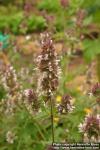 Latin names: Nepeta cataria and other Nepeta species.
Latin names: Nepeta cataria and other Nepeta species.
2.31.1 Growing catnip
From snielsen.orednet.org (Susan L. Nielsen):
To all catnip culture hopefuls... my own tale of woe.
I guess the point was mainly to grow it for the cats, but I had anticipated waiting until the holidays and using it for gifts.
The first time, I naively plunked the catnip among the mints and pennyroyals. The poor little transplant never pushed its roots out from the pot-shaped ball they came in. The neighbor cats ripped it out of the ground and played football with it all afternoon -- this I judge from its condition when I arrived home from work the second evening.
Silly me, I thought then that a bit of wire would keep the cats off it. I tenderly re-planted the invalid Nepeta with a bit of poultry wire arranged over the top and staked into the soil. I have always wondered what happened to the wire...
After this second violation, the plant did not look a likely candidate for survival. In medical terms, its condition was 'grave.'
So I brought home another, and planted it in the top of a _large_, heavy imported Italian terra cotta pot. Filled with soil, this pot weighs in at about 75 pounds. Imagine my horror, when I returned home the following evening, to find the pot overturned, the soil excavated, the catnip plant nowhere to be found, but significant tufts of animal fur scattered among the wreckage. It passed through my mind that this might not be an ordinary cat at work, but, perhaps, Something Larger? The yellow tiger-colored hairs did, however, suggest a domestic visitor over an apricot catamount.
I next (jaw set, grim determination in my eye) planted catnip in a plastic pot hung by 3 chains from the cross-bar of the clothesline. With pliars I closed the hook that passed through the eye of the bar. I arranged new chicken wire over the top of the pot. I put cast-off barbed wire at the base of the clothesline pole, and anchored it with iron stakes driven in at angles. I stood back to admire my work. It looked like an industrial construction project on the perimeter of a prison.
I have always prided myself on effective design in the garden...
On the following evening, I probably need not tell, the catnip had again been ravaged. The scene was improbable. The pot, still attached by one of three chains, hung at a debauched angle. Its contents had spilled into the barbed wire at the base of the installation.
Among those wires were traces of catnip leaves, and quantities of yellow and white fur, soft fur, tinged with spots of blood. Bits of perlite from the potting medium clung to the red spots. The catnip, and the nipped cat, were nowhere in evidence.
I adopted a philosophical outlook then, as I surveyed the result of the day's work. I decided it might be a better thing to not grow catnip in the garden.
SuN.
From Judi Burley <jburley.TRIANON.WORLDTEL.COM>:
Regarding Catnip. I use a cage over mine. Just an old birdcage. Then the cats can get at what grows out of the cage but the base plant is safe. By the way I put the cage over the plant and then drive the cage into the ground well. Works great.
From Jennifer A. Cabbage <fxjac.camelot.acf-lab.alaska.edu>:
Catnip is a very hardy perennial that is native to the dry regions of the Mediterranean, inland Europe, Asia, and Africa. Cataria grows to 4 feet tall and somewhat resembles stinging nettle. Mussinii grows to 1 foot, sprawls. It has a citrus-like scent and is sometimes called catmint. In order to keep cats away from catnip avoid bruising the leaves, which releases the oils. "If you sow it cats won't know it, if you set it cats will get it," is an apt saying.
Catnip loves full sun but can tolerate partial shade, and does well in almost any garden soil (pH between 5 and 7.5). It is more pungent when it is grown in sandy soil with full sun.
Catnip is easily grown from seed, and can also be propagated from root division. Plant seeds 1/4 in. deep or shallower, they will usually germinate promptly. Space seedlings 18 to 24 in. apart, they transplant fairly happily. (However, transplanting them brings them to the attention of the felines.) Catnip grows well in pots and windowboxes, and even though it is a perennial, it may have to be re-planted a couple times a year to replace those plants ravaged by the cats.
2.31.2 Harvesting catnip
From Jennifer A. Cabbage <fxjac.camelot.acf-lab.alaska.edu>:
Harvest as needed for fresh leaves. Harvest flowering tops for drying, usually in July and September.
2.31.3 Using / preserving catnip
From Jennifer A. Cabbage <fxjac.camelot.acf-lab.alaska.edu>:
Catnip can be used to add an unusual flavor to sauces, soups and stews.

